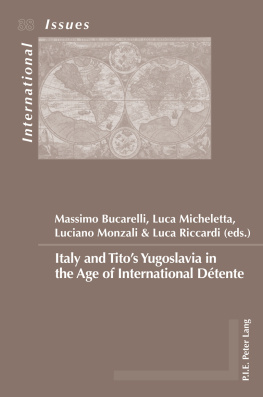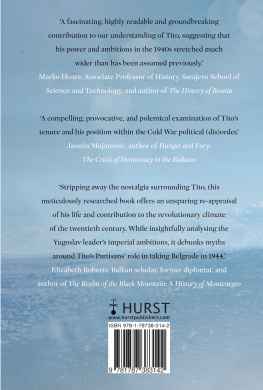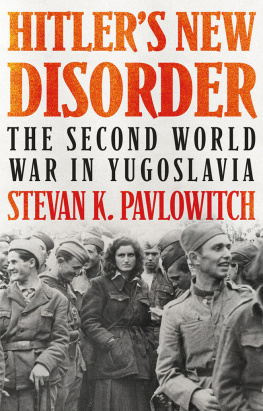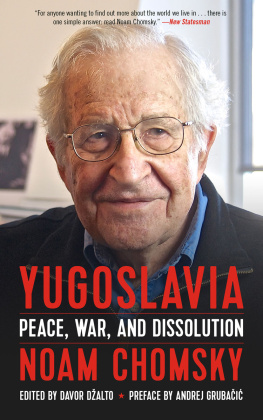Bucarelli - Italy and Tito’s Yugoslavia in the Age of International Détente
Here you can read online Bucarelli - Italy and Tito’s Yugoslavia in the Age of International Détente full text of the book (entire story) in english for free. Download pdf and epub, get meaning, cover and reviews about this ebook. year: 2016, publisher: Peter Lang AG, genre: Politics. Description of the work, (preface) as well as reviews are available. Best literature library LitArk.com created for fans of good reading and offers a wide selection of genres:
Romance novel
Science fiction
Adventure
Detective
Science
History
Home and family
Prose
Art
Politics
Computer
Non-fiction
Religion
Business
Children
Humor
Choose a favorite category and find really read worthwhile books. Enjoy immersion in the world of imagination, feel the emotions of the characters or learn something new for yourself, make an fascinating discovery.
Italy and Tito’s Yugoslavia in the Age of International Détente: summary, description and annotation
We offer to read an annotation, description, summary or preface (depends on what the author of the book "Italy and Tito’s Yugoslavia in the Age of International Détente" wrote himself). If you haven't found the necessary information about the book — write in the comments, we will try to find it.
Bucarelli: author's other books
Who wrote Italy and Tito’s Yugoslavia in the Age of International Détente? Find out the surname, the name of the author of the book and a list of all author's works by series.
Italy and Tito’s Yugoslavia in the Age of International Détente — read online for free the complete book (whole text) full work
Below is the text of the book, divided by pages. System saving the place of the last page read, allows you to conveniently read the book "Italy and Tito’s Yugoslavia in the Age of International Détente" online for free, without having to search again every time where you left off. Put a bookmark, and you can go to the page where you finished reading at any time.
Font size:
Interval:
Bookmark:

Italy and Titos
Yugoslavia in the Age
of International Dtente

P.I.E. Peter Lang
Bruxelles Bern Berlin Frankfurt am Main New York Oxford Wien
Massimo B UCARELLI , Luca M ICHELETTA ,
Luciano M ONZALI and Luca R ICCARDI (eds.)
Italy and Titos
Yugoslavia in the Age
of International Dtente
International Issues
Vol. 38
This book has been published thanks to the financial support of : Dipartimento di Storia, Societ e Studi sullUomo (Universit del Salento, Lecce); Dipartimento di Scienze Politiche (Sapienza Universit di Roma); Dipartimento di Scienze Politiche (Universit degli Studi di Bari Aldo Moro).
This publication has been peer-reviewed.
No part of this book may be reproduced in any form, by print, photocopy, microfilm or any other means, without prior written permission from the publisher. All rights reserved.
P.I.E. Peter Lang s.a.
ditions scientifiques internationales
Brussels, 2016
1 avenue Maurice, B-1050 Brussels, Belgium
ISSN 2030-3688
ISBN 978-2-87574-313-8
eISBN 978-3-0352-6587-3
D/2016/5678/13
CIP available from the British Library, UK and from the Library of Congress, USA.
Die Deutsche National Bibliothek lists this publication in the Deutsche Nationalbibliografie; detailed bibliographic data is available on the Internet at http://dnb.de.
About the author(s)/editor(s)
Massimo Bucarelli teaches History of International Relations and Diplomatic History at the Department of History, Society and Human Studies, at the University of Salento (Lecce).
Luciano Monzali is Associate Professor of History of International Relations at the Political Sciences Department in the University of Bari Aldo Moro.
Luca Micheletta is Associate Professor of History of International Relations at the University of Rome Sapienza.
Luca Riccardi is Full Professor of History of International Relations at the University of Cassino and Lazio Meridionale.
About the book
World War II and East-West confrontation redefi ned borders between Italy and Yugoslavia, reshaped national frontiers and adversely affected political relations. As a result, major quarrels and disputes arose over territorial claims, demarcation of State boundaries, expulsion of national minorities, and diverging visions on international and domestic politics. It was only in the 1960s and 1970s, during the years of Dtente, that rapprochement between Rome and Belgrade became possible and normalization of bilateral relations was attained. Long-lasting territorial disputes, such as the Trieste question, were solved and bilateral relationship greatly improved, so much so that Belgrade became an important asset in Italys Balkan and Adriatic strategy, while Rome was a sort of bridge between Socialist Yugoslavia and Western Europe.
This book is intended to shed light on the process of Italian-Yugoslav normalization and rapprochement, which ultimately brought to the Adriatic Dtente. Based on a wide collection of primary sources and documentary materials, it aims to contribute to a better understanding of the history of the Adriatic region, a confl icted European space that had been affected by territorial disputes and ethnic strife for decades during the 20th century.
This eBook can be cited
This edition of the eBook can be cited. To enable this we have marked the start and end of a page. In cases where a word straddles a page break, the marker is placed inside the word at exactly the same position as in the physical book. This means that occasionally a word might be bifurcated by this marker.
| 9
After the Second World War, political and diplomatic relations between Italy and Yugoslavia were characterized by misunderstandings, polemics and hostility, which were mainly, though not exclusively, due to the Trieste question, a territorial dispute that had divided the two Adriatic countries for decades. After Italys defeat in the Second World War and Yugoslavias attempt to take possession of Trieste and most of Venezia Giulia, the Peace Treaty of 10 February 1947 assigned the whole Italian territory to the east of the Tarvisio-Monfalcone line to Yugoslavia, with the exception of a narrow coastal belt which included Trieste (Zone A), occupied by the Anglo-Americans, and Koper (Zone B), under Yugoslav occupation. Under the Peace Treaty this coastal area was envisaged as a buffer state, the Free Territory of Trieste, which was to be formally built through the appointment of a governor by the UN Security Council.
As a consequence of the war, Italy passed from the status of an imperial power to that of a mere object of international policy, searching in vain to influence the fate of the border areas. Instead, Yugoslavia was in a position of strength. As a victorious country that had been attacked by Italy, Yugoslavia could legitimately sue for reparations, and it would try to devise a grand foreign policy design to create a regional scenario which would avert the danger of finding itself encircled by hostile powers one more time in the post-war period. However, the division of Europe into opposing political and ideological blocs made the establishment of FTT impossible. Cold War and bipolar logic turned the Trieste question from a local problem into the Adriatic version of the Iron Curtain. In the light of containment policy adopted by the US government in response to the power policy of the Soviets and to the expansion of the communist movement, the defense of Trieste took on a new importance: the Adriatic city became a sort of a Western shield intended to contain any communist infiltration into Northern Italy. It was for this purpose that the governments in London and Washington postponed the appointment of the governor of the FTT by the UN and preferred to wait for an agreement between Rome and Belgrade, a hypothesis which was virtually impossible at that time.
However, a few months after the ratification of the Peace Treaty, a new variable was added to the already complicated framework of Italian-Yugoslav relations: during 1948 a political, more than ideological, breakup occurred within the communist world. Following the Tito Stalin split, Yugoslavia moved away from the Soviet orbit and subsequently closer 9 | 10 to the Western bloc, which from that moment became the main source of economic and military aid to Titos regime. The realignment of Yugoslav policy affected the evolution of the Trieste question. Given the importance of Belgrade for the political and military strategies of Washington and London and due to the impossibility to create the FTT because of unbridgeable differences between Italy and Yugoslavia, the Anglo-Americans favored a compromise: the London Memorandum of 5 October 1954. By the terms of the agreement, Italian officials replaced British and American authorities in the administration of Zone A of the FTT, while in Zone B Yugoslav military administration had to be replaced with a civil administration. It was the de facto partition of the FTT, which was intended to eliminate a dispute considered harmful for the Western bloc. Despite the normalization of the bilateral relations that followed the signature of the Memorandum, Italy and Yugoslavia failed to establish an atmosphere of cordiality and friendly collaboration essential for the solution of the Trieste question. The government in Belgrade expected Italy to formally recognize the extension of Yugoslav sovereignty over Zone B of the still-born FTT. Italys government, instead, reaffirmed the practical and provisional nature of the Memorandum, aiming at launching new negotiations in order to get further territorial acquisitions in addition to Trieste and Zone A.
Font size:
Interval:
Bookmark:
Similar books «Italy and Tito’s Yugoslavia in the Age of International Détente»
Look at similar books to Italy and Tito’s Yugoslavia in the Age of International Détente. We have selected literature similar in name and meaning in the hope of providing readers with more options to find new, interesting, not yet read works.
Discussion, reviews of the book Italy and Tito’s Yugoslavia in the Age of International Détente and just readers' own opinions. Leave your comments, write what you think about the work, its meaning or the main characters. Specify what exactly you liked and what you didn't like, and why you think so.









